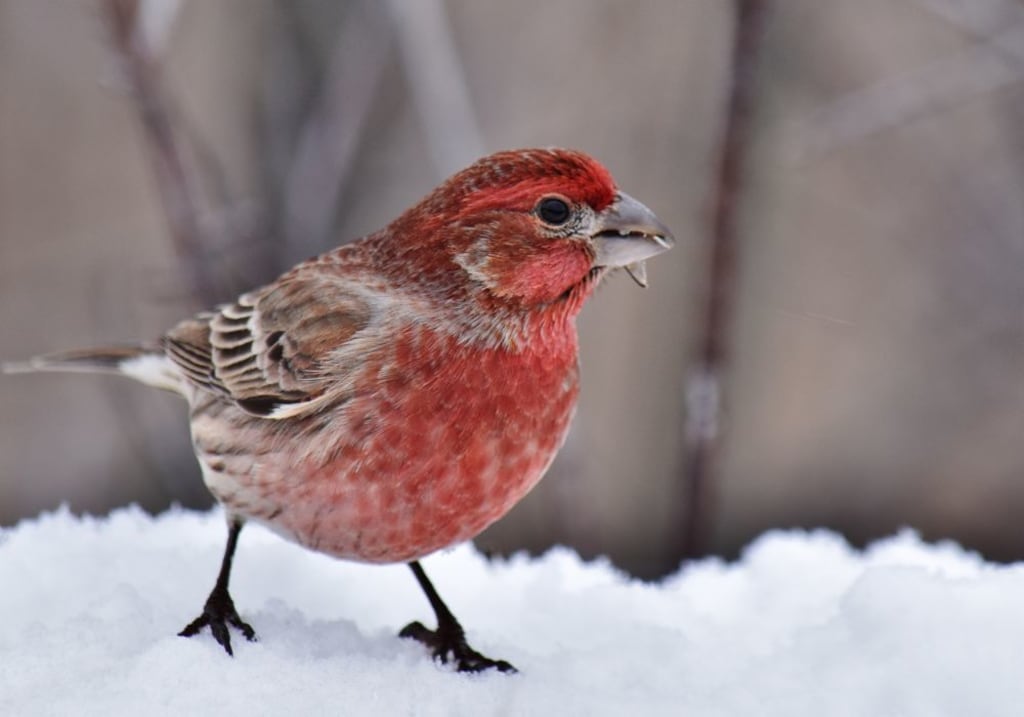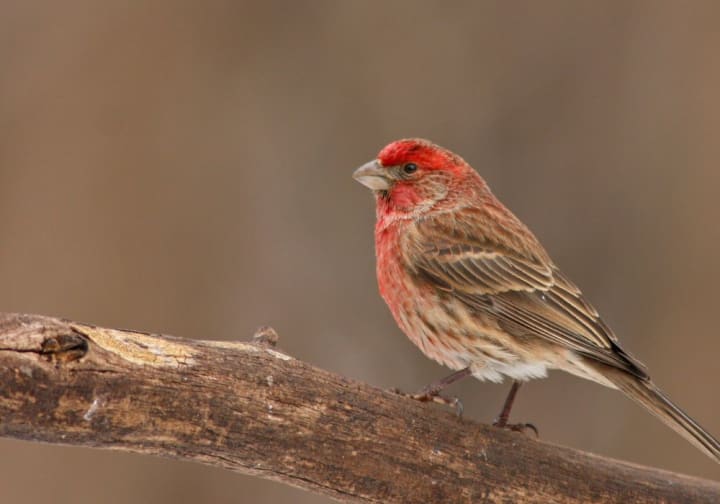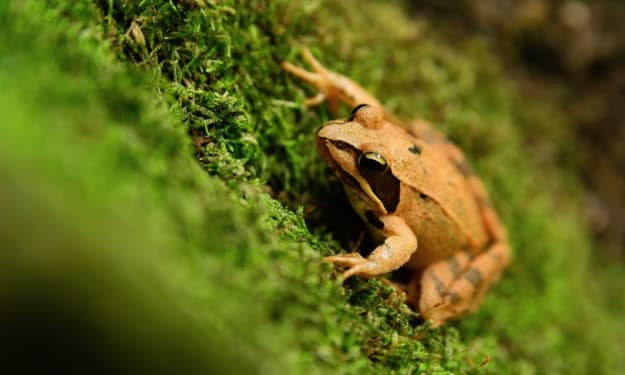Discovering the Birds of a Feather
Types of Finches in North America

Introduction to Finches in North America
Finches are a family of small passerine birds that inhabit North America and the surrounding region. They are found throughout the continent from coast to coast, in both rural and urban areas. Finches typically have parrot-like beaks that enable them to feed on seeds, grains, and other foods. There are many types of finches in North America, from the well-known house finch to rarer species with specialized diets and behaviors. The different types of finches in North America vary by size, coloration, diet, habitat preference, and behavior. Some common species include the house finch, American goldfinch, purple finch, Cassin's finch, cedar waxwing, evening grosbeak, pine siskin, and common redpoll.
The house finch is the most widespread type of North American finch; it can be found in yards from coast to coast. House finches are easy to recognize with their bright red plumage on males and dull colors on females. The American goldfinch is also a familiar sight in many gardens across North America; these birds have yellow plumage with black wings and tail feathers . The purple finch is another type of North American finch that can be spotted regularly; its distinctive coloration makes it easily recognizable even at a distance. Less common species like Cassin's Finch and cedar waxwing may require more effort to spot due to their much smaller populations or more particular habitats.
No matter where you’re located in North America or what type of environment you’re exploring , there’s sure to be some type of finches nearby for you to observe . All types of Finches in North America offer unique behaviors worth checking out , so observe closely when given the chance !
Overview of Types of Finches Found in North America
Birds of a feather will flock together and finches are no exception. With over 40 types of finches found in North America, these small birds are quite common. Types of finches in North America are divided into two categories - the Old World finches and the New World finches.
Old World finches are closely related to sparrows, buntings, weavers and waxbills. These species are mostly brown, black or gray with some having bright colors on their wings and tails. Some examples include the House Finch, Eurasian Tree Sparrow, Common Chaffinch and Brambling.
The New World finches belong to the family of Fringillidae which includes many birds like canaries, crossbills, grosbeaks and siskins. These birds have more vibrant colors than their Old World counterparts with some varieties sporting red, pink or yellow feathers. Some examples include the Pine Grosbeak, Red Crossbill, Cassin's Finch and Evening Grosbeak.
When choosing which type of North American finch is best for you, it is important to consider not only your own preferences but also the habitat you have available for them to live in. Each species has its own set of specific needs such as food sources, nesting locations, temperature ranges and social behavior that must be taken into account when selecting your bird companion.
No matter what type of finch you pick there is no doubt that any one of them will offer you a unique experience unlike any other pet out there. From watching them hop around your garden to listening to their cheerful chirps; discovering the birds of a feather – types of finches in North America – is a journey worth taking!
Characteristics of Common Types of Finches
Finches are small passerine birds that belong to the family Fringillidae. Types of finches in North America come in a wide variety of shapes and sizes. From the tiny Black-capped Chickadee to the striking Scarlet Tanager, these birds can be found all across the continent. In this blog, we will discuss various characteristics of some common types of finches found in North America.
Goldfinch
The most popular finch in North America is undoubtedly the Goldfinch. The male goldfinch has a bright yellow color on its face, wings, and tail feathers. The female goldfinches are more dull in comparison but still have a bold yellow hue on their wings and tails. Goldfinches can be found all over North America, from Alaska to Florida and everywhere in between. They tend to feed on flower buds and seeds which makes them a popular choice for backyard birdwatchers.
House Finch
The House Finch is one of the most easily recognizable birds in North America. Its distinctive red plumage makes it easy to spot amongst other backyard birds. The males have bright red heads while females are brown or gray with red streaks on their rumps. This species is native to western Mexico but has been introduced into other parts of North America due to human activity. They are commonly seen at backyard birdfeeders eating sunflower seeds and suet cakes.

Purple Finch
The Purple Finch is one of the prettiest finches you will find in North America. Males have a vibrant purple color on their head, back, wings, and tail feathers while females may have some hints of pink or purple but usually appear brownish overall with streaks on their sides or chests. They feed mainly on insects such as caterpillars, flies, moths, and beetles as well as berries and seeds from plants like sumac and wild cherry trees making it easy for them to survive during harsh winters months when food is scarce .
American Goldfinch
The American Goldfinch is sometimes mistaken for its cousin the Goldfinch mentioned above but there are some distinct differences between them including size, shape, and coloring as well as behavior patterns . Males American Goldfinches tend to have brighter yellow feathers than those belonging to the Goldfinch species . Additionally , they feed mainly on thistle , teasel , dandelion , clover , grasses , millet , sunflower weeds , grains , fruits such as apples cherries blueberries raspberries blackberries mulberries elderberries strawberries huckleberries currants serviceberries elderberry kiwi oranges pears plums lime grapes figs satsumas tangerines quince mangoes papaya watermelons cucumbers tomatoes zucchini pumpkins squash acorns beechnuts chestnuts nuts almonds hazelnuts Brazil nuts pecans walnuts coconuts oak galls water lily buds bursages willow catkins cattails buds blossoms flaxseed cornmeal oat meal crushed eggshells lard bacon fat sugar syrup honey peanuts peanut butter nectar sap eggs insects larvae spiders centipedes millipedes sowbugs mites snails slugs mayflies ant pupae mollusks crustaceans .
Female American goldfinches also look different since they lack bright coloration compared the males . Overall, finches are incredibly diverse birds that come in a variety of shapes sizes colors behaviors found all over North America . Not only do they bring beauty with their colorful plumage but also provide excellent entertainment for wildlife enthusiasts looking watch observe enjoy these amazing creatures nature’s wonders .
Breeding and Mating Habits of Finches
Finches are a type of small passerine bird that belong to the Fringillidae family. In North America, there are many different types of finches that can be found. Knowing how they breed and mate can help birders identify them in the wild.
Types of Finches in North America
In North America, there are three main types of finches - purple finches, house finches, and pine siskins. All three are somewhat similar in appearance with colorful markings on their feathers - often a combination of browns, reds, and yellows. However, they each have their own unique characteristics that help to differentiate them from one another.
Breeding Habits
Each species of finch has their own breeding habits depending on climate and conditions but typically it is the male who will build the nest during mating season which is usually between April and June in North America. The female will lay between 3-7 eggs which she will then incubate for between 11-14 days before hatching. The male may also assist in feeding the young chicks after they hatch until they are able to fly and forage for food on their own.
Mating Habits
Finches will typically mate with the same partner year after year although some may switch partners if necessary. During courtship rituals, males may display by puffing up their feathers or singing to attract females - some species even have specific mating songs that they use only during this time! Males may also bring food or nesting material to the female as part of this ritual as well.
Conclusion
Finches can be found throughout much of North America and come in three main varieties - purple finches, house finches, and pine siskins. Each species has its own unique breeding and mating habits that help them survive in various climates throughout the continent. From building nests to singing mating songs, these birds have adapted over time so that they can thrive in nature!
Feeding Habits and Diet of Finches
Finches in North America are known for their unique and varied habits when it comes to feeding. Generally speaking, the diet of finches can range from fruits, seeds, nectar, insects, and even other small animals. Depending on the type of finch found throughout North America, their feeding habits will differ on a species-by-species basis.
Types of Finches in North America
There is a wide variety of finches found in North America including species like the American Goldfinch, Purple Finch, House Finch, House Sparrows and many more. Of these finch species, each one will have different dietary needs based on their own natural habitat. For example, American Goldfinches primarily feed on seeds such as thistle or sunflower seed which they acquire by clinging onto the stems with their beaks. On the other hand, House Finches typically feed off of insects and other small animals that they find in trees or shrubs around their natural habitats.
Varied Diets for Different Species
Other finch species have different diets as well. For instance, Purple Finches enjoy a wide range of food sources making them omnivores; they eat everything from fruits to insects to nectar. House Sparrows prefer to feed off of seeds like millet or hemp but also consume grains like wheat or corn if available as an alternative food source. These finches also enjoy eating insects when they come across them while scavenging for food sources as well.
Supplemental Feeding
Depending on where you live in North America, you might even be able to partake in supplemental feeding for some of these finch species! If you live near an area with wild birds you can provide an additional food source by supplying birdfeeders full of grain-based seed mixes like millet or sunflower seed that are specifically designed for different types of birds including finches. This can be a great way to observe these beautiful birds up close while also providing them with extra nourishment during colder months when food sources can become scarce!
All in all, there is much diversity among the types of finches living in North America when it comes to diet and feeding habits; however given their overall resilience and adaptability they are able to survive even during times when food sources become limited due to seasonal changes - making them excellent candidates for observing if you're looking into bird watching!
Conservation Status and Threats to Wild Finch Populations
Types of finches in North America are renowned for their beautiful colors and enchanting chirps. From the famous American Goldfinch to the Red Crossbill, wild finch populations have been a staple of the North American ecosystem. Unfortunately, many finch species are increasingly at risk due to various threats that have caused their populations to decline over the years.
The International Union for Conservation of Nature (IUCN) has classified 36 species of finches as at least near threatened, vulnerable, or endangered on its Red List of Threatened Species. These species include Thick-billed Parrot, Elegant Trogon, and Bullock's Oriole. Factors such as habitat loss due to deforestation or anthropogenic activities like pesticides and urbanization are major contributors to the decline in wild finch populations across North America. In addition, climate change has also been identified as a threat for some species, with changes in temperature affecting their habitat range and food availability.
Other threats include shifts in land use practices that leave less open space or grasslands for birds to feed and breed in; pollution from industrial waste; competition from exotic birds; illegal hunting or capture; disease transmission from domestic poultry; and predation by feral cats and other predators. All of these factors contribute to a reduction in wild finch populations across North America.
Fortunately, many organizations have taken up conservation measures such as habitat restoration projects or captive breeding programs that aim to protect these species from further decline. With increased education on wildlife protection and conservation efforts such as creating bird sanctuaries or protected areas for birds, we can ensure the long-term survival of these beautiful creatures that bring so much life into our world.
Conclusion
North America is home to a wide variety of finches, each unique in their own way. From the brightly coloured Goldfinch and House Finch to the small but resilient Purple Finch, there is something special about each of these avian wonders. With careful observation, you can discover the distinct behaviors and traits that make these birds so vital members of our ecosystem. Not only do they provide valuable insights into our environment, but they also serve as an important reminder of how much beauty and diversity can be found in nature. So next time you are out bird-watching or just enjoying the outdoors, take a moment to appreciate all types of finches in North America and the unique roles they play in our lives.
About the Creator
Hasan
Welcome...
In this site of mine you can learn amazing things and many information that you don't know so please subscribe to my site.
Enjoyed the story? Support the Creator.
Subscribe for free to receive all their stories in your feed. You could also pledge your support or give them a one-off tip, letting them know you appreciate their work.






Comments (2)
Wow, very nice, thanks.
Hey, just wanna let you know that this is more suitable to be posted in the Earth community 😊